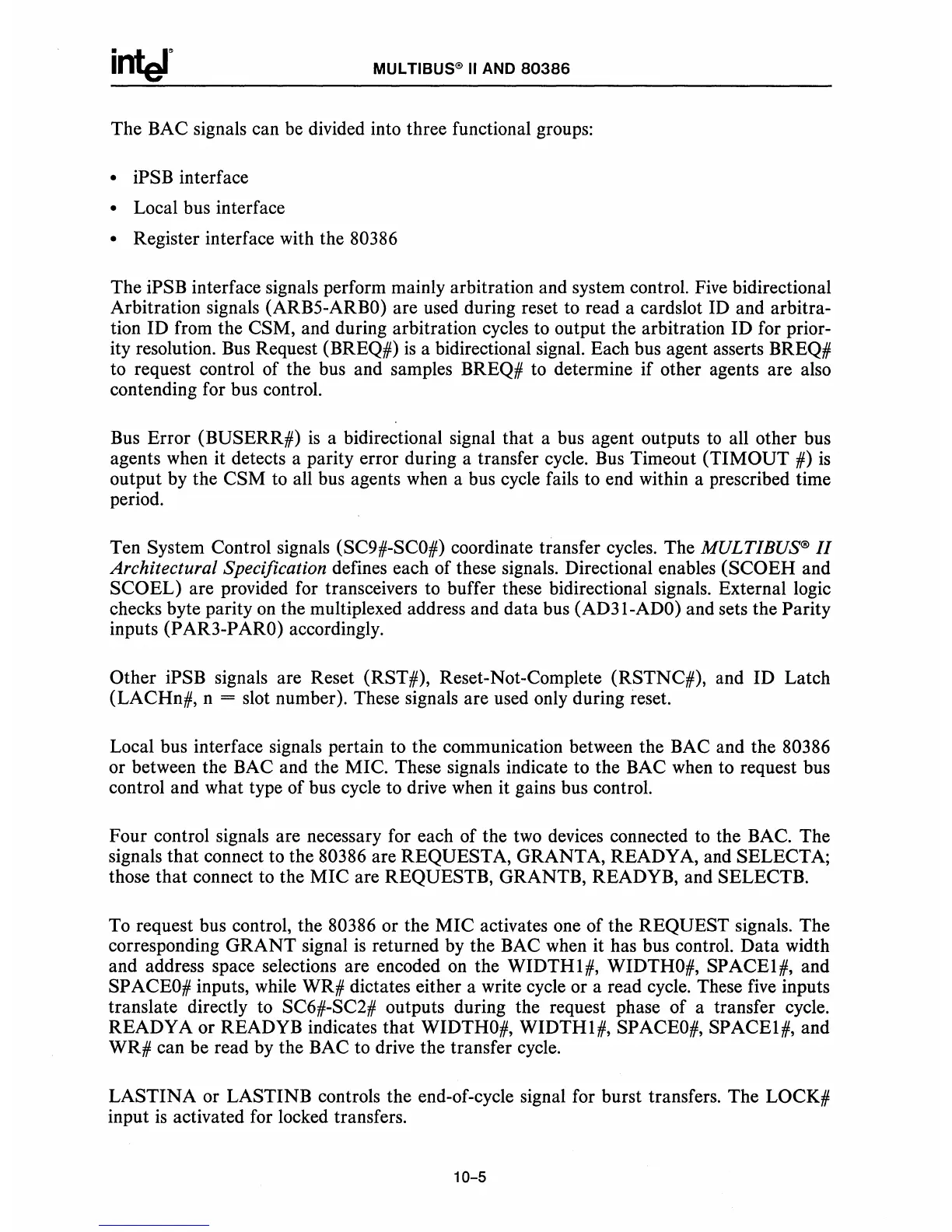MUL TIBUS®
II
AND
80386
The BAC signals can be divided into three functional groups:
• iPSB interface
• Local bus interface
• Register interface with the 80386
The iPSB interface signals perform mainly arbitration and system control. Five bidirectional
Arbitration signals
(ARB5-ARBO) are used during reset to read a cards lot ID and arbitra-
tion ID from the
CSM, and during arbitration cycles to output the arbitration ID for prior-
ity resolution.
Bus
Request (BREQ#)
is
a bidirectional signal. Each bus agent asserts BREQ#
to request control of the bus and samples BREQ#
to
determine if other agents are also
contending for bus control.
Bus Error
(BUSERR#)
is
a bidirectional signal that a bus agent outputs
to
all other bus
agents when it detects a parity error during a transfer cycle.
Bus
Timeout (TIMOUT #)
is
output by the CSM to all bus agents when a bus cycle fails to end within a prescribed time
period.
Ten
System Control signals (SC9#-SCO#) coordinate transfer cycles. The MULTIBUS®
II
Architectural Specification defines each of these signals. Directional enables (SCOEH and
SCOEL) are provided for transceivers to buffer these bidirectional signals. External logic
checks byte parity
on
the multiplexed address and data bus (AD31-ADO) and sets the Parity
inputs (PAR3-PARO) accordingly.
Other iPSB signals are Reset (RST#), Reset-Not-Complete (RSTNC#), and ID Latch
(LACHn#, n
= slot number). These signals are used only during reset.
Local bus interface signals pertain to the communication between the BAC and the
80386
or between the BAC and the MIC. These signals indicate to the BAC when to request bus
control and what type of bus cycle to drive when it gains bus control.
Four control signals are necessary for each of the
two
devices connected to the BAC. The
signals that connect to the
80386 are REQUESTA, GRANT
A,
READY
A,
and SELECTA;
those that connect to the MIC are
REQUESTB, GRANTB, READYB, and SELECTB.
To request bus control, the
80386 or the MIC activates one of the REQUEST signals. The
corresponding
GRANT
signal
is
returned
by
the BAC when it has bus control. Data width
and address space selections are encoded
on
the
WIDTHl#,
WIDTHO#, SPACEl#, and
SP ACEO# inputs, while WR# dictates either a write cycle or a read cycle. These
five
inputs
translate directly to
SC6#-SC2# outputs during the request phase of a transfer cycle.
READYA or READYB indicates that
WIDTHO#,
WIDTHl#,
SPACEO#, SPACEl#, and
WR# can be read
by
the BAC to drive the transfer cycle.
LAS
TINA
or LASTINB controls the end-of-cycle signal for burst transfers. The LOCK#
input
is
activated for locked transfers.
10-5

